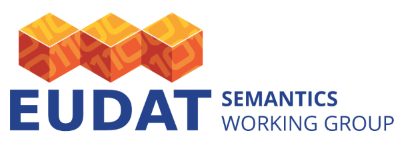
What is the issue?
Linking data resources stored in EUDAT with the scientific concepts describing them allows for better data interoperability within the considered scientific domain as well as for efficient data retrieval based on familiar terms for the scientists. Furthermore, providing semantic information lays the ground for cross-domain data integration. Such enrichment of the data resources can be done using the semantic web technologies and relies on domain specific ontologies or thesauri. The need for adding semantic as EUDAT common services has been identified during two different workshops (see reports). As a result of these workshops, the semantic Working Group has been created to identify the key technologies and develop prototype tools that should be integrated within the EUDAT infrastructure as common services.
What objectives have been set?
The overall goal of this working group is to develop and integrate semantic web tools as common EUDAT services to support scientists.
To achieve this ambitious and extensive goal, the Working Group decided to focus first on the following practical aspects:
- Developing a prototype of an annotation service (B2NOTE) based on a well-defined use-case: the LTER/LifeWatch use case (see report Semantics at the 2nd EUDAT conference)
- Make ontologies/terminologies/thesauri discoverable: start an ontology repository using B2SHARE
- Developing a community of expert to share knowledge and good practices in semantic web and ontology building: EUON (EUropean Ontology Network).
- Store and use semantic annotation: deploy a prototype triple store in EUDAT infrastructure.
What are the achievements to-date?
Since its creation the Working Group has been quite active and a large part of the initial objectives have been already fulfilled:
- B2NOTE prototype version 1: first prototype version built using python and common semantic python libraries like RDFlib and SPARQLWrapper. This webservice allows annotating imported text/documents with terms coming from Bioportal, EnvThes and GEMET from EIONET. This prototype is currently being tested and extended using the Django RESTful framework to be further integrated with the LTER/LifeWatch portal
- EUON activities: Since its official launch in May 2014, EUON has attracted more than hundred members from Europe and abroad, working in academic institutions but also in industry. We organized a first workshop during the 3rd EUDAT meeting, which gathered more than 70 attendees out of 112 registered people. The background of the participants was extremely diverse. Despite a large representation of the Biomedical/Bioinformatics community, attendees were also from humanities, arts, government, NGOs, Inter-Governmental Organisations (e.g. UN), physics, computer science, engineering, education, broadcasting and more. In addition to this successful workshop, EUON organized a panel discussion at the International Semantic Web Conference in Italy, which drew the interest of the Semantic Web practitioner community.
- Ontologies in B2SHARE: in a first attempt to create a repository for ontologies, 10 ontologies were submitted (EFO, EnvThes, …) for test. Based on this initial ontology set, we will extend the services offered around this repository in collaboration with the developer team of B2SHARE.
In the near future, we will deploy a first triple store instance within the EUDAT infrastructure and interlink it with the existing semantic web services described above.
How does the WG work?
Workgroup is composed of core members involved in the different activities. We coordinate during the various EUDAT meetings and have regular meeting to discuss and update the workplan.
Who is involved?
- Yann Le Franc, Working Group Chair (e-Science Data Factory, France)
- Herbert Schentz (UBA, Austria)
- David Vicente (BSC, Spain)
- Johannes Peterseil (UBA, Austria)
- James Malone (EBI, UK)
Useful Links / Documents
- EUON: www.euon.org
- B2NOTE: http://b2note.bsc.es/query/
- B2SHARE: https://b2share.eudat.eu (search for EUON collection:EUON)
